Native name 경의선(京義線) | Line length 56.1 km (34.9 mi) Stations 23 | |
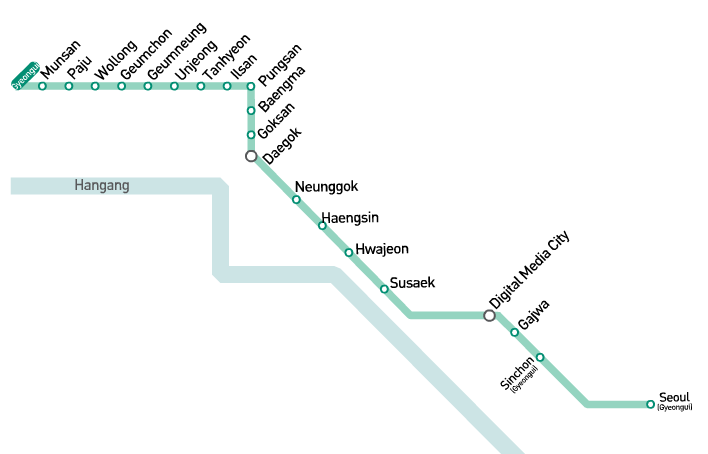 | ||
Type Heavy rail, Passenger/FreightRegional rail Opened November 5, 1905 (actual opening)April 1, 1908 (passenger service)July 1, 2009 (Seoul Metropolitan Subway service) Track gauge 1,435 mm (4 ft 8 ⁄2 in) standard gauge Owner Korea Rail Network Authority Terminis | ||
Seoul subway haengsin station gyeongui line goyang south korea
The Gyeongui Line is a railway line between Seoul and Dorasan Station in Paju. Korail operates the Seoul Metropolitan Subway service between Seoul Station and Munsan Station.
Contents
- Seoul subway haengsin station gyeongui line goyang south korea
- Korail driver seat
- History
- Inter Korea border
- Upgrade
- Seoul Metropolitan Subway
- Regular rail service
- KTX
- Stations
- References
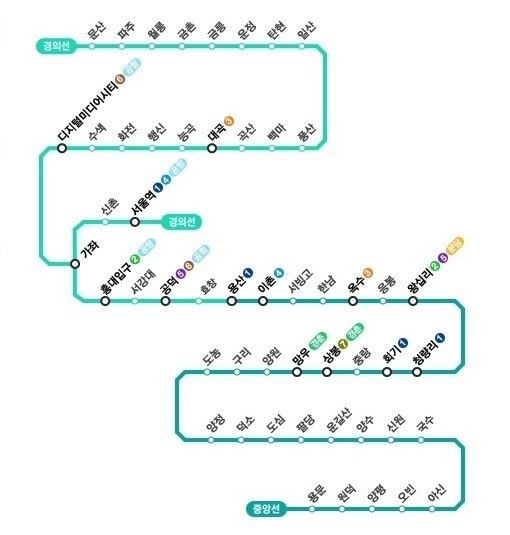
Korail driver seat
History
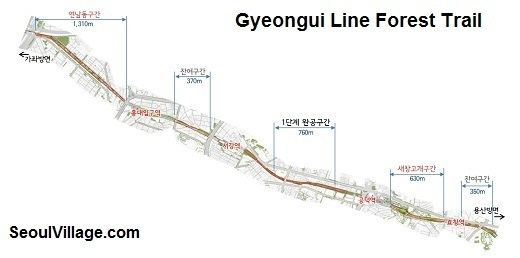
Originally the line continued to P'yŏngyang and Sinŭiju, both of which are now in North Korea, or even to the South Manchuria Railway, linking the Korean railway system to the rest of Asia and Europe.
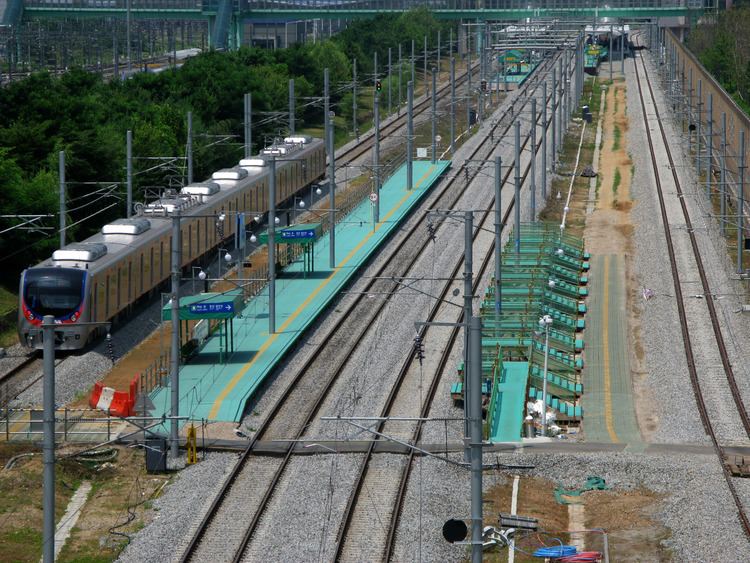
The Korean Empire intended to build the Gyeongui Line with its own resources at the end of the 19th century, but the project stalled due to lack of funds. Imperial Japan, which gained to concession to build the Gyeongbu Line from Busan to Seoul, also sought to gain control of the Gyeongui Line project as its continuation further north, recognising the trunk route as a means to keep Korea under its influence. The line was also advanced for military considerations in expectation of a confrontation with Russia, which came in 1904 as the Russo-Japanese War. At the start of the war, Japan ignored Korea's declaration of neutrality and transported troops to Incheon, and forced the Korean government to sign an agreement that gave Japan's military control of railway projects if deemed necessary for military operations. Japan's military began to build the Gyeongui Line, while troop bases were established in connection with the railway, the biggest of them next to the terminus of the line, Yongsan Station in Seoul.
The first section of the Gyeongui Line opened from Yongsan in Seoul to Munsan on April 3, 1906.
Inter-Korea border
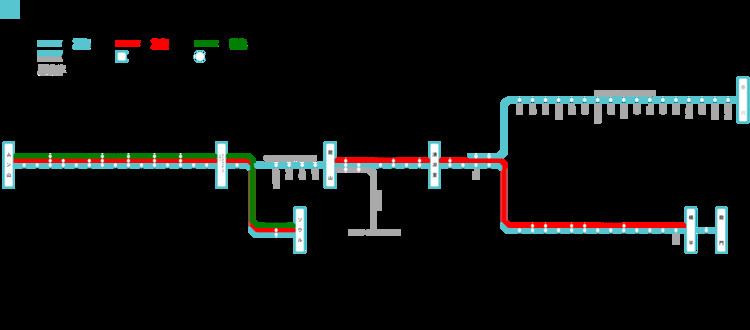
After the division of Korea in 1945, trains stopped operating between the north and south halves of the country, meaning that southern trains probably terminated at Kaesŏng, which is now in North Korea but was at the time part of the US-administered southern zone. Northern trains would have terminated north of Kaesŏng.
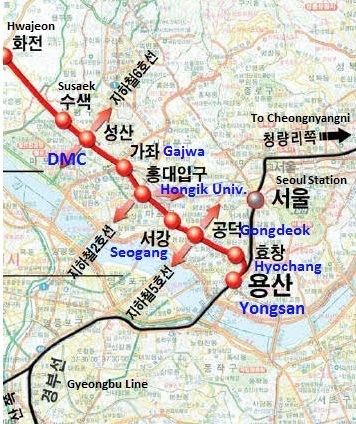
After the end of the Korean War in 1953, southern trains were cut back to around Munsan (north of Seoul), with northern trains terminating at Kaesŏng. Around the same time, North Korea renamed the P'yŏngyang-Kaesŏng section of the line as the P'yŏngbu (P'yŏngyang + Busan) Line and the P'yŏngyang-Sinŭiju section as the P'yŏngŭi (P'yŏngyang + Sinŭiju) Line. The DPRK sector is now 100% electrifed, although the double track section spans only from Pyongyang to Sunan Airport.
Since the summit between the two Koreas in 2000, an effort has slowly been underway to reconnect the Gyeongui Line. Southern passenger service has been extended to Dorasan on the edge of the Demilitarized Zone (DMZ) and tracks have been built across the DMZ itself. In October 2004, the Northern connection from the DMZ to Kaesŏng was finally completed. Simultaneous test runs along the rebuilt cross-border sections of both the Gyeongui Line and the Donghae Bukbu Line were set for May 25, 2006, but North Korean military authorities cancelled the plans a day ahead of the scheduled event. However, at a meeting held in Pyongyang, North Korea, on April 22, 2007, North and South Korea agreed to restart the project. On May 17, 2007, the first train, carrying North and South Korean delegations, travelled from Munsan Station in the South to Kaesong in the North. The first test run on the Donghae Bukbu Line took place at the same time. According to South Korean representatives, the North has agreed in principle to regular passenger and freight service along the two train lines.
Upgrade
Meanwhile, work began to upgrade the South Korean section for high-capacity commuter services. Between Seoul and Munsan, the line is converted into an electrified, double-tracked railway in a new, straighter, 48.6 km long alignment. Work began in November 1999, with a budget originally estimated at 1,970 billion won. The section from Digital Media City (DMC) to Munsan was finished on July 1, 2009. The remaining section will be mostly underground between Gajwa Station in northwestern Seoul to Yongsan Station in downtown Seoul. As of 2009, construction progress on the entire Seoul–Munsan section reached 74% of a total budget then estimated at 2,153.271 billion won. The section is to be finished by 2014 and the freed area on the surface is to be turned into a park.
The line is to be further upgraded for 230 kilometres per hour (140 mph), as part of a government strategic plan to reduce travel times for 95% of Korea to under 2 hours by 2020, which was announced on September 1, 2010.
Seoul Metropolitan Subway
The Gyeongui Line opened as a part Seoul Metropolitan Subway on July 1, 2009 from Seoul to Munsan. The line connects Seoul, Digital Media City, Ilsan, Paju, and Munsan, and offers transfers to Line 3, Line 6, and AREX.
The main line terminated at Digital Media City Station when first opened, while a separate branch continued to Seoul Station. On December 15, 2012, the main line was extended to Gongdeok Station, providing transfers to Line 2 and Line 5. On December 27, 2014, the main line service was further extended to Yongsan Station from Gongdeok Station, and the service was renamed to the Gyeongui–Jungang Line following the merging of the line with the Jungang Line.
The term "subway" in reference to this line is somewhat of a misnomer, as the line runs underground for less than three percent of its length. The upgraded line simply follows alignment of the old line built 100 years ago. The outer portion of the line runs largely through countryside rice paddies, forests, and vegetable fields, and outside of Seoul rarely enters urbanized areas. It is mostly at-grade, and includes several at-grade crossings with local roads, where Korail employees stand by on duty to stop traffic.
Regular rail service
Before the integration with the subway system, the most common service on the line was a Tonggeun train service between Seoul and Imjingang, with one Saemaeul-ho train. Since the line was integrated with the Seoul Subway system, Tonggeun service had been restricted to a few stations in the north, from Munsan to Imjingang, with a few continuing on to Dorasan, near the North Korean border.
KTX
There is a depot for Korea Train Express (KTX) trains along the Gyeongui Line at Haengsin Station. Some KTX services thus continue beyond Seoul respective Yongsan Station and terminate at Haengsin Station.
The line may see more KTX service after the upgrade for 230 km/h considered in the government's strategic plan for 2020.
Stations
This list does not include stations served only by Gyeongui-Jungang Line metro trains.
Uncheon, Imjingang, and Dorasan stations are planned to become a part of the Gyeongui-Jungang Line sometime after 2020.
